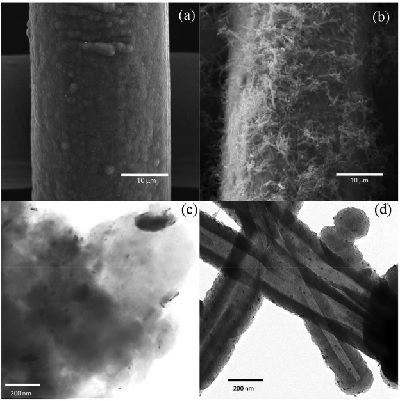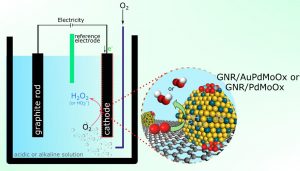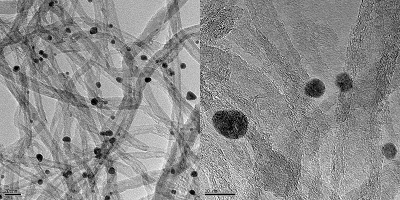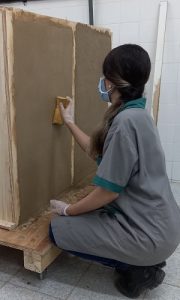|
|||||||||||||||||||||||||||||||||||
|
|||||||||||||||||||||||||||||||||||
|
|
|||||||||||||||||||||||||||||||||||
|
|||||||||||||||||||||||||||||||||||
|

A team of researchers from the Brazilian Federal University of Paraná (UFPR) has developed a low-cost biosensor capable of detecting Covid-19 antibodies in about 30 minutes and with high sensitivity. The system has shown promise for producing handheld, disposable devices that could be used to diagnose coronavirus infection or to confirm antibody production after vaccination using just a few drops of blood.
Biosensors are systems that have a biological element (in this case, the N protein of the SARS-CoV-2 virus) responsible for chemically interacting with what you want to detect (in this case, the specific antibody for that antigen). When the interaction takes place, the chemical reaction is transformed in the device into an interpretable signal.
The biosensor developed at UFPR is based on a stainless steel mesh coated with a hybrid material which is formed by a polymer that conducts electricity (polypyrrole) and gold nanoparticles. In these nanoparticles, virus proteins are immobilized, so that antibodies from blood samples, if any, come into contact with their antigens, spontaneously react with them and become detectable.
Facing the pandemic
The idea of the research emerged at the beginning of the Covid-19 pandemic, when society needed to have systems for the detection of the virus and the antibodies generated by the infection. At that moment, Professors Dênio Souto and Marcio Vidotti, from UFPR, decided to gather their expertises in sensors and related topics and be part of the global efforts.
“We already knew from the beginning that the urgency and multidisciplinary nature of the subject would increase our challenge”, says Bruna M. Hryniewicz, first author of the article that reports this research in the journal Materials Today Chemistry. Bruna took part in the research during her PhD, still in progress, under the guidance of Professor Vidotti, both from the Research Group on Macromolecules and Interfaces at UFPR.
A detection system was built based on the doctoral thesis of Ana Leticia Soares, which has just been defended by UFPR. With the guidance of professors Marcio Vidotti and Luis Fernando Marches, the work resulted in a platform formed by a conductive polymer modified with gold nanoparticles that showed promising responses when joined to several pairs of antigens and antibodies.
More sensitivity and selectivity

Starting from this platform, the team investigated some issues that could improve the sensitivity and selectivity of the biosensor – parameters that allow reducing the amount of false positives and negatives in the detection results, even in small amounts of sample.
In this sense, the authors synthesized and characterized two polypyrrole morphologies to produce the hybrid material, the globular and the nanotubular, and found that the polymeric nanotube biosensor had a sensitivity eight times higher to detect antibodies than the globular polypyrrole system.
Another important point was the choice of the method of immobilization of the N protein in the nanoparticles. The researchers chose to promote a covalent bond (chemical bond based on the sharing of electron pairs between the atoms involved), which brings more stability and sensitivity to the system. In fact, this methodology positions the antigen in an orientation in which the sites of interaction with the antibody are available – an interaction that is further encouraged by the favorable chemical environment provided by polypyrrole. “All these characteristics allow the biosensor to present satisfactory sensitivity and selectivity responses”, says Jaqueline Volpe, also the first author of the article, who participated in the research during her master’s degree, under the guidance of Professor Dênio Souto, both from the Spectrometry, Sensors and Biosensors.
In addition to the participation of professors, post-docs and students from the Graduate Program in Chemistry at UFPR, the collaboration of researchers and physicians from UFPR and Hospital Erasto Gaertner, in Curitiba, was fundamental in the research. These collaborators quickly provided the SARS-CoV-2 N protein. They also obtained blood samples from people with and without Covid-19 who had had PCR tests (the diagnostic methodology considered the most accurate), which were used to test the performance of the biosensor.
“Taking into account that the work was carried out during the height of the pandemic, the challenges were numerous, from access to laboratories, to the exploration of a highly relevant topic, which generates greater pressure in the development of research”, comments Larissa Bach Toledo, co-author of the article.

According to the authors, the biosensor developed is promising for use on a large scale in the diagnosis of infected people and in the monitoring of antibodies due to the simple and scalable method of manufacturing the electrodes (batch synthesis), added to the low cost of the stainless steel matrix, and the high sensitivity of the system. However, to produce it commercially, it would be necessary to do many more validation tests with real samples, as well as transforming the system into a simple, miniaturized and easy to use device, in which the detection results could be interpreted by anyone.
This research was funded by the German foundation Alexander von Humboldt, UFPR through Proind 2020 and the Brazilian agencies CAPES and CNPq. The work also received support from INCTBio, of which Professor Marcio Vidotti is a member.

Reference of the paper: Development of polypyrrole (nano)structures decorated with gold nanoparticles toward immunosensing for COVID-19 serological diagnosis. B. M. Hryniewicz, J. Volpe, L. Bach-Toledo, K. C. Kurpel, A. E. Deller, A. L. Soares, J. M. Nardin, L. F. Marchesi, F. F. Simas, C. C. Oliveira, L. Huergo, D. E. P. Souto, M. Vidotti. Materials Today Chemistry. Volume 24, June 2022, 100817. https://doi.org/10.1016/j.mtchem.2022.100817.
Contact of the corresponding authors: denio.souto@ufpr.br and mvidotti@ufpr.br.
|
||||||||||||||||||||||||||||||||||
|
||||||||||||||||||||||||||||||||||
|

Hydrogen peroxide (H2O2) is a compound widely used, especially as a bleach or antiseptic in the production of pulp and paper, in cleaning, pharmacy and beauty products and in the treatment of wastewater, among other applications. With a large and growing market, the production of hydrogen peroxide has the challenge of becoming more sustainable, using methods that are environmentally friendly and allow the compound to be obtained in the same place where it will be used, reducing risks, costs and the environmental impact of transport. In this scenario, producing hydrogen peroxide in electrochemical generators using basically water, air and electricity is a promising path, which some companies are already treading. However, the success of this process largely depends on having efficient, stable and low-cost catalysts.
In a recently published scientific article, a team made up of researchers from the Brazilian Federal University of Mato Grosso do Sul (UFMS), Federal University of Grande Dourados (UFGD), and the São Carlos Institute of Chemistry (IQSC-USP) made a contribution in this regard. They developed catalysts based on graphene nanoribbons and metallic nanoparticles and studied in detail their performance in the electrochemical production of hydrogen peroxide. In addition to showing that these catalysts significantly improve reaction efficiency, equating to the best conventional catalysts in some aspects, the study advanced the understanding of fundamental phenomena that open possibilities to continue optimizing the electrocatalytic production of hydrogen peroxide.

“We proposed the synthesis of catalysts with a low content of noble metal (≤6.4% by mass), with high catalytic efficiency and high durability for the electrochemical production of H2O2”, says Professor Gilberto Maia (UFMS), co-author of the article. Indeed, noble metals such as gold and palladium are known for their catalytic properties but have the disadvantage of cost. “Our catalysts were built from oxides of molybdenum, gold and palladium, which together form nanoparticles anchored on the surface of graphene nanoribbons”, describes Maia.
The team tested the efficiency of the catalysts in terms of generating hydrogen peroxide through the two-electron oxygen reduction reaction (ORR-2e– ), in which one molecule of oxygen, two hydrogen cations and two electrons form one molecule of hydrogen peroxide. Mainly, the researchers tested, with very positive results, the activity of the catalyst (its ability to increase the rate of reaction), its selectivity (its ability to direct the reaction towards a certain product, in this case, hydrogen peroxide) and its stability (the ability to maintain its properties over time).
“The results we obtained showed that the improved catalytic activity for ORR-2e– was promoted by a combination of factors including geometry, palladium content, interparticle distance and active site blocking effects, while the electrochemical stability of the catalysts may have been enhanced by the presence of molybdenum”, says Professor Maia.
The work was developed within a collaboration between researchers from the Institute of Chemistry at UFMS and the Environmental Electrochemistry Research Group at IQSC-USP, who have been working together on the synthesis, characterization and application of electrocatalytic materials. According to the authors, the main idea and the first combinations of synthesis emerged as an offshoot of the doctoral thesis by Guilherme Fortunato, which was supervised by Professor Gilberto Maia and was defended in UFMS in 2019. The work continued and finalized within the postdoctoral research of Fortunato, carried out at IQSC under the supervision of Professor Marcos Lanza.
The research was funded by Brazilian federal and state agencies Capes, CNPq, FAPESP and FUNDECT-MS.

Paper reference: Using Palladium and Gold Palladium Nanoparticles Decorated with Molybdenum Oxide for Versatile Hydrogen Peroxide Electroproduction on Graphene Nanoribbons. Guilherme V. Fortunato, Leticia S. Bezerra, Eduardo S. F. Cardoso, Matheus S. Kronka, Alexsandro J. Santos, Anderson S. Greco, Jorge L. R. Júnior, Marcos R. V. Lanza, and Gilberto Maia. ACS Applied Materials & Interfaces 2022 14 (5), 6777-6793. DOI: 10.1021/acsami.1c22362.
Corresponding authors contact: g.fortunato@usp.br and gilberto.maia@ufms.br.
|
||||||||||||||||||||||||||||||||||||||||||||||||||||
|
||||||||||||||||||||||||||||||||||||||||||||||||||||
|
Edson Roberto Leite was an undergraduate student of materials engineering when he began to work with research in sintering. At the time, his advisor was Professor José Arana Varela, a distinguished materials scientist who died in 2016 and was founding member and president of the Brazilian Materials Research Society.
Used since antiquity, sintering is a process of agglutination of solid particles that results in a compact material. In this process, the spaces between the particles or grains (the pores) are filled by atoms that detach from the surface of the material.
“I have always been very interested in this subject and curious to know what transport is like at the atomic level during the sintering process”, recalls Edson Leite.
More than thirty years after this first scientific work, Leite, who now is the scientific director of the Brazilian Nanotechnology National Laboratory (LNNano), calmed this curiosity. Together with other researchers at LNNano, he was able to visualize, in real time and with atomic resolution, the process of eliminating pores in a nanometric zirconium oxide ceramic. The work was recently published in Nano Letters.
“Certainly Prof. Varela would be proud and enjoy this work”, says Leite, who received the José Arana Varela Award from B-MRS last year in recognition of his scientific trajectory.
The first step of the work was taken four years ago, when Leite and his team developed a methodology that allowed the preparation of monolayers of self-supported nanoparticles (without substrate). When they took these very thin films to a transmission electron microscope (TEM), the researchers noticed that the electron beam induced the transport of atoms, even at room temperature. The team then saw the possibility of studying the sintering process in situ. That is, being able to follow the changes in pore filling under the microscope, step by step and without having to remove the sample in the middle of the process.
The possibility took shape in LNNano’s high-resolution TEM, an HRTEM, which allows one to visualize atoms. “We put together a team made up of Jefferson Bettini (researcher at LNNano), my postdoc Tanna Rodrigues Fiuza and Marlon Muniz da Silva (intern at LNNano and now a PhD student at LNLS) and started to work hard to visualize sintering at the atomic scale,” says Leite.

Initially, the team prepared ceramic films formed by nanometric grains of zirconium oxide and focused their efforts on studying the process that occurs at the end of sintering: the elimination of isolated pores that remain at the grain boundaries.
The work was as exciting as it was challenging, not only because of the hours spent at the microscope in collecting, processing and analyzing images, but mainly because of the researchers’ effort to understand what they were seeing. “In the end, we were quite happy and demonstrated the transformations that occur during the closing of pores on an atomic scale”, says Leite.
In this video, filmed by the authors of the article using HRTM, it is possible to visualize atoms migrating from adjacent grains and filling the pore:
The work should have an important academic impact, since its results show that the reality of nanometric ceramics does not fit, in some aspects, in the theoretical models that are used to explain sintering processes. “Most existing models involving sinter kinetics consider the surface energy and the energy of isotropic grain boundaries. We showed that this does not occur in nanometric ceramics”, explains Professor Leite. “In addition, we showed that a transition occurs in which a rough surface is eliminated and the appearance of faceted surfaces occurs, indicating that there may be a thermodynamic barrier, in addition to a kinetic barrier for atomic transport”, he adds. “In summary, we can say that it is necessary to modify the existing models to explain the sintering process at the nanoscale”, concludes the scientist.
According to the authors, the work should also have an impact on the ceramic industry, as a better understanding of the sintering process can lead to the development of nanostructured ceramics with controlled porosity and particle size and, therefore, with differentiated mechanical and electronic properties.
Reference of the paper: Visualization of the Final Stage of Sintering in Nanoceramics with Atomic Resolution. Tanna Elyn Rodrigues Fiuza, Marlon Muniz da Silva, Jefferson Bettini, and Edson Roberto Leite. Nano Lett.2022, 22, 1978 – 1985. https://doi.org/10.1021/acs.
Author contact: edson.leite@lnnano.cnpem.br

[Text by Professor Petrus Santa Cruz (DQF/UFPE), B-MRS member]
It is difficult to assess the indirect impacts of the Covid-19 pandemic, and it is even more difficult to receive, even at this point, news from direct victims, such as that of a long-time collaborator, Hernán Valenzuela, who left us on the 7th of March.
As a senior representative of the Fraunhofer ENAS Institute (Fraunhofer-Instituts für Elektronische Nanosysteme ENAS) in Latin America, nearly 20 years ago Hernán began to bring together researchers involved in the application of new materials in nanotechnologies in the Minapim Seminar, a biennial series of which Hernán has been chairman since his first edition in 2004, together with the creation of the MTM Minapim News Technology Magazine, initiatives initially supported by the Superintendence of the Manaus Free Trade Zone (SUFRAMA). In the 2018 edition of the Minapim Seminar, emphasis was given to the consolidation of the international cooperation agreement between the Fraunhofer Institute ENAS and UFPE, having interacted in events involving new technologies since the first international events in the area, in 2003 at Nanofair (Switzerland) and NanoTech (Japan).
In 2013, he gave support to the UFPE’s Workshop for the Bioterium of Nanostructured Species BEN at SUFRAMA’s headquarters (Manaus), involving discussions on Biodiversity and Bioinspiration, within the scope of the Capes Nanobiotec Brasil Project.
As a result of the collaborations catalyzed by Hernán, in March 2020 a team including the President Director of Fraunhofer ENAS at the time, Dr. Thomas Otto, visited Ponto Quantico Nanodevices (Positiva, LandFoton/UFPE), when Ponto Quantico became the Hub of the Fraunhofer ENAS Cooperation Agreement with UFPE, and the team was received by the Rector Alfredo Gomes, a few days before the Recife campus lockdown, when the WHO declared the beginning of the ongoing pandemic.
Hernán, who was a sociologist, leaves a wife, four children, five grandchildren and many friends, many of them from our scientific community.
Prof. Petrus Santa Cruz (DQF/UFPE)
|
|||||||||||||||||||||||||||||||||||||||||
|
|||||||||||||||||||||||||||||||||||||||||
|

Like other sectors of the economy, civil construction faces an important challenge: to progressively reduce greenhouse gas emissions and become increasingly sustainable. In this sense, there are efforts in the scientific community to develop construction materials that have a positive environmental impact at all stages of the building process, starting with the extraction of raw materials, going through the use of the buildings and reaching the recycling of waste at the end of the life cycle of the product. To this end, one of the strategies being explored is the incorporation of natural raw materials, such as raw earth and biomass, into construction materials.
In an article recently published in the journal Construction and Building Materials, a Brazilian scientific team reports the development and study of mortars based on raw earth and plant biomass residues (bamboo particles) with potential for use as internal wall plaster. In addition to analyzing the properties of these mortars, the authors evaluated their environmental impact, mainly in relation to the carbon dioxide emissions involved in their preparation, use and disposal.
“The main contribution of this work is to show the feasibility of producing mortars based on locally available natural resources (raw earth and plant biomass – bamboo) in the construction of a portfolio of low carbon and low energy consumption constructive solutions”, says Romildo Dias Toledo Filho, professor of the Civil Engineering Program at Coppe, the postgraduation and research institute in Engineering at the Federal University of Rio de Janeiro (UFRJ), who led the work.
To produce the mortars, the scientific team used raw earth, bamboo particles, hydrated lime, Portland cement and natural sand, among other ingredients. Bamboo particles were obtained from waste from the furniture sector in the state of Rio de Janeiro and processed to obtain fibers of a few hundred micrometers in diameter and up to 2 cm in length.
Four types of mortar were produced: one without bamboo and the others with different proportions of particles (3, 6 and 9% of the total volume). In addition to studying its physical, mechanical and thermal properties, the authors quantified the greenhouse gas emissions involved in the mortar’s life cycle. Using well-established methodologies, the researchers evaluated the developed earth mortars and compared them with conventional mortars. The study considered the entire life cycle of the material.
The research showed good results for earth and bamboo mortars and explained the weight of each factor in the carbon emissions involved in the process, pointing out ways to reduce them even more. Earth mortars, especially those with a higher proportion of bamboo, presented lower emissions than conventional mortars due to the carbon stock of bamboo. In fact, vegetal biomass extract carbon dioxide from the atmosphere through photosynthesis and use it to grow. When this biomass is incorporated into a mortar, the carbon remains stored and its emission is avoided. This environmental gain is enhanced when residues from biomass processing are used as a source of raw material, as occurred in this work.
In addition, density, thermal conductivity and resistance tests showed that earth mortars with bamboo, especially the one containing 6% biomass, can perform very well as plaster for internal walls of buildings, as they have adequate adhesion and resistance, and improve the energy efficiency of the environments. “Earth mortars that incorporate plant biomass present the peculiarity of open porosity, and this characteristic gives them the potential to act as a coating and passive material for hygrothermal regulation of the internal microclimate of the environments, making them more salubrious, providing better conditions of health to the occupants and reducing energy consumption for artificial air conditioning”, explains Professor Romildo.
The work was developed within the PhD in Civil Engineering of Rayane de Lima Moura Paiva, with funding from CNPq and FAPERJ and guidance from Professor Romildo and Professor Lucas Rosse Caldas. The study is part of a research line on earth and biomass mortars that is underway at Coppe’s Sustainable Materials Center in partnership with a group from ETH Zürich (Switzerland).

Scientific article reference: Potentiality of earth-based mortar containing bamboo particles for GHG emissions reduction. Rayane de Lima Moura Paiva, Lucas Rosse Caldas, Adriana Paiva de Souza Martins, Romildo Dias Toledo Filho. Construction and Building Materials. Volume 317, 24 January 2022, 125971. https://doi.org/10.1016/j.conbuildmat.2021.125971
Author contact: Prof. Romildo Dias Toledo Filho – toledo@coc.ufrj.br
 Prof. Ana Flavia Nogueira (UNICAMP), B-MRS member, became associate editor of two important journals of the Royal Society of Chemistry: Materials Advances and Journal of Materials Chemistry C.
Prof. Ana Flavia Nogueira (UNICAMP), B-MRS member, became associate editor of two important journals of the Royal Society of Chemistry: Materials Advances and Journal of Materials Chemistry C.
At B-MRS, the scientist was elected a member of the Deliberative Council, with a term of office from 2022 to 2026.